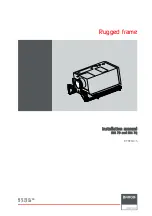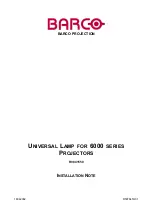
OPTIMOD-FM DIGITAL
INTRODUCTION
1-15
If the transmitter is accessible:
You can achieve the most accurate control of modulation peaks by locating
OPTIMOD-FM at the transmitter site and then using its stereo encoder to drive the
transmitter. You can usually also obtain good results by locating OPTIMOD-FM at the
studio and connecting the baseband output of its stereo encoder to the transmitter
through a composite baseband STL (see page 1-18). However, many composite base-
band STLs do not control peaks perfectly because of bounce (see page 1-19), and lo-
cating OPTIMOD-FM at the transmitter site (where it can control peaks just prior to
the transmitter’s RF exciter) is thus likely to maximize loudness.
Because OPTIMOD-FM controls peaks, it is irrelevant whether the audio link feeding
OPTIMOD-FM’s input terminals is phase-linear. However, the link should have low
noise, the flattest possible frequency response from 30-15,000Hz, and low non-linear
distortion.
We strongly recommend that you use the 8600S’s internal stereo encoder to feed
the output of the encoder directly to the baseband input of the exciter through less
than 100 feet (30 meters) of coaxial cable. 100 feet of coaxial cable (assuming
30pF/foot capacitance) will reduce measured separation at 15 kHz (worst case) to
approximately 55 dB. (See Figure 2-3 on page 2-9.) This separation is comfortably
above the separation (approximately 20 dB) that starts to cause perceptible changes
in the stereo image.
You will achieve a louder sound on the air, with better control of peak modulation,
than if you use most external stereo encoders.
An exception is Orban’s 5518 stereo encoder, which does not add overshoot and
contains its own overshoot limiter and composite limiter equivalent to the one in
the 8600S when operated in its stand-alone stereo encoder mode.
The shorter the baseband cable from OPTIMOD-FM to exciter, the less likely that
ground loops or other noise problems will occur in the installation. If you require a
long cable run, you can use a Jensen JT-123-BMCF transformer
to break any ground
loops. This transformer will ordinarily cure even the most stubborn hum or noise
caused by the composite connection between OPTIMOD-FM and the exciter. For
3
Julie M. Adkins and Robert D. Sorkin: “Effect of Channel Separation on Earphone-
Presented Tones, Noise, and Stereophonic Material,”
J. Audio Engineering Society
,
vol. 33 pp. 234-239, 1985.
Subjects listened to 500-Hz tones, broadband noise, and stereophonic program ma-
terial through earphones and adjusted the channel separation, via a manual control,
until the degradation of the spatial effect became detectable. Mean channel separa-
tions ranged from 10 to 15.9 dB for the musical selections employed and from 13.7
to 16.8 dB for the noise and tonal stimuli. The results are discussed in terms of exist-
ing data on detectable stereo separation and on the discrimination of interaural
time differences. [Abstract ©Audio Engineering Society, Inc.]
4
http://www.jensen-transformers.com/wp-content/uploads/2014/08/jt-123-bmcf.pdf
Содержание OPTIMOD-FM 8600S
Страница 1: ...Operating Manual OPTIMOD FM 8600S Digital Audio Processor Version 2 1 Software ...
Страница 7: ...Operating Manual OPTIMOD FM 8600S Digital Audio Processor Version 2 1 Software ...
Страница 56: ......
Страница 166: ......
Страница 254: ...3 88 OPERATION ORBAN MODEL 8600S ...
Страница 326: ......
Страница 328: ...6 28 TECHNICAL DATA ORBAN MODEL 8600S CONTROL BOARD PARTS LOCATOR ...
Страница 334: ...6 34 TECHNICAL DATA ORBAN MODEL 8600S 5700 8600S I O DSP BOARD PARTS LOCATOR DRAWING 32370 860 01 ...
Страница 339: ...OPTIMOD FM DIGITAL TECHNICAL DATA 6 39 8600S I O BOARD COMPOSITE SCA DAUGHTERBOARD SHEET 4b of 12 62310 000 02 1 ...
Страница 348: ...6 48 TECHNICAL DATA ORBAN MODEL 8600S FRONT REAR FRONT PANEL PARTS LOCATOR DIAGRAM 32275 000 09 ...
Страница 352: ...6 52 TECHNICAL DATA ORBAN MODEL 8600S ...
Страница 353: ...OPTIMOD FM DIGITAL TECHNICAL DATA 6 53 ...
Страница 354: ...6 54 TECHNICAL DATA ORBAN MODEL 8600S ...
















































